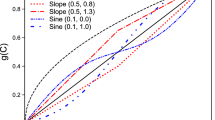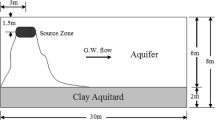Abstract
Following the accidental subsurface release of dense nonaqueous phase liquids (DNAPLs), spatial variability of physical and chemical soil/contaminant properties can exert a controlling influence on infiltration pathways and organic entrapment. DNAPL spreading, fingering, and pooling typically result in source zones characterized by irregular contaminated regions with complex boundaries. Spatial variability in aquifer properties also influences subsequent DNAPL dissolution and aqueous transport dynamics. An increasing number of studies have investigated the effects of subsurface heterogeneity on the fate of DNAPL; however, previous work was limited to the examination of the behavior of single-component DNAPL in systems with simple and well-defined aqueous and solid surface chemistry. From a DNAPL remediation point of view, such an idealized assumption will bring a large discrepancy between the designs based on the model simulation and the reality. The research undertaken in this study seeks to stochastically explore the influence of spatially variable porous media on DNAPL entrapment and dissolution profiles in the saturated groundwater aquifer. A 3D, multicomponent, multiphase, compositional model, UTCHEM, was used to simulate natural gradient water flooding processes in spatially variable soils. Porosity was assumed to be uniform or simulated using sequential Gaussian simulation (SGS) and sequential indicator simulation (SIS). Soil permeability was treated as a spatially random variable and modeled independently of porosity, and a geostatistical method was used to generate random distributions of soil permeability using SGS and SIS (derived from measured grain size distribution curves). Equally possible 3D ensembles of aquifer realizations with spatially variable permeability accounting of physical heterogeneity could be generated. Tetrachloroethene (PCE) was selected as a DNAPL representative as it was frequently discovered at many contaminated groundwater sites worldwide, including Thailand. The randomly generated permeability fields were incorporated into UTCHEM to simulate DNAPL source zone architecture under 96-L hypothetical PCE spill in heterogeneous media and stochastic analysis was conducted based on the simulated results. Simulations revealed considerable variations in the predicted PCE source zone architecture with a similar degree of heterogeneity, and complex initial PCE source zone distribution profoundly affected PCE recovery time in heterogeneous media when subject to natural gradient water flush. The necessary time to lower PCE concentrations below Thai groundwater quality standard ranged from 39 years to more than 55 years, suggesting that spatial variability of subsurface formation significantly affected the dissolution behavior of entrapped PCE. The temporal distributions of PCE saturation were significantly altered owing to natural gradient water flush. Therefore, soil heterogeneity is a critical factor to design strategies for characterization and remediation of DNAPL contaminated sites. The systematic and comprehensive design algorithm developed and described herein perhaps serves as a template for application at other DNAPL sites in Thailand.








Similar content being viewed by others
References
Bear J (1972) Dynamics of fluids in porous media. Elsevier, New York
Deutsch CV, Journel AG (1998) GSLIB: Geostatistical software library and user’s guide, 2nd edn. Oxford University Press, New York
Drummond CD, Lemke LD, Rathfelder KM, Hahn EJ, Abriola LM (2000) Simulation of surfactant-enhanced PCE recovery at a pilot test field site. In: Wickramanayake GB, Gavaskar AR, Gupta N (eds) Treating dense nonaqueous phase liquids (DNAPLs): remediation of chlorinated and recalcitrant compounds. Batelle, Columbus, pp 77–84
Goovaerts P (1999) Impact of the simulation algorithm, magnitude of ergodic fluctuations and number of realizations on the spaces of uncertainty of flow properties. Stoch Environ Res Risk Assess 13:161–182
Lemke LD, Abriola LM, Goovaerts P (2004) Dense nonaqueous phase liquid (DNAPL) source zone characterization: influence of hydraulic property correlation on predictions of DNAPL infiltration and entrapment. Water Resour Res 40:W01511
Schad H (1993) Geostatistical analysis of hydraulic conductivity related data based on core samples from a heterogeneous fluvial aquifer. In: Vincenzo C, Giovanni G, Donator P (eds) Statistics of spatial processes: theory and applications. It Stat Soc, Bari, pp 205–212
Srivastava RM (1994) An overview of stochastic methods for reservoir characterization. In: Yarus JM, Chambers RL (eds) Stochastic modeling and geostatistics: principles, methods, and case studies. American Association of Petroleum Geology, Tulsa, pp 1–16
Acknowledgments
The authors thank Dr. Lawrence D. Lemke for gathering all necessary information regarding the site in Oscoda, Michigan, USA. Also, the authors thank Water Resources System Research Unit at Chulalongkorn University (CU_WRSRU) for partially providing some computational facility to Suwit Rodphai to conduct this work.
Author information
Authors and Affiliations
Corresponding author
Rights and permissions
About this article
Cite this article
Putthividhya, A., Rodphai, S. Use of geostatistical models in DNAPL source zone architecture and dissolution profiles assessment in spatially variable aquifer. Environ Earth Sci 70, 1983–1991 (2013). https://doi.org/10.1007/s12665-013-2713-4
Received:
Accepted:
Published:
Issue Date:
DOI: https://doi.org/10.1007/s12665-013-2713-4




